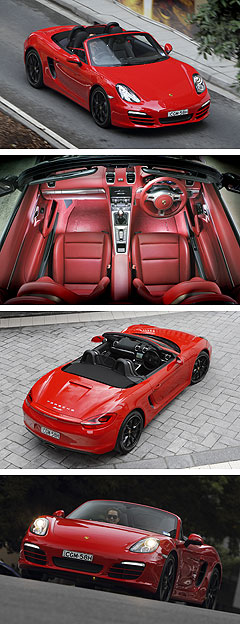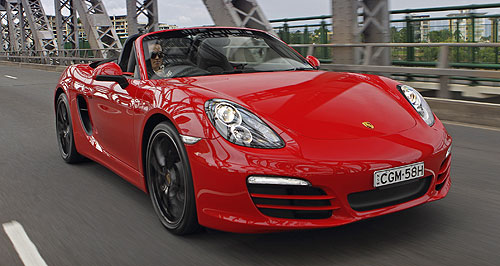Make / Model Search
New models - Porsche - BoxsterFirst Oz drive: Porsche's trimmed-down BoxsterSporty German: Porsche's lighter and more fuel efficient third-generation Boxster has arrived in Australia. Lighter Porsche Boxster delivers higher levels of performance and fuel efficiency12 Jun 2012 THE latest generation of the roadster by which all others are measured has landed in Australian showrooms, lighter, faster, more fuel efficient and a little more expensive than before. The 981-series Porsche Boxster – the third iteration of the two-seat mid-engined German cabrio since it debuted in 1997 – comes hard on the heels of the Australian launch of the flagship Porsche 911 in an unprecedented double-whammy for the hardcore sportscar company. The next chapter will unfold later this year when the related Cayman coupe is formally unveiled at the Los Angeles motor show in November ahead of its early 2013 rollout locally. Porsche Cars Australia hopes the new, more muscular-looking Boxster will appeal to a younger, broader audience, and finally step out from under the shadow of the 911. Once Porsche’s biggest seller until the appearance of the Cayenne SUV, the Boxster range has now received its biggest renovation to date. The extent of the changes are reflected in the pricing, which ranges from $107,500 (plus on-road costs) for the six-speed manual Boxster to $139,100 for the dual-clutch automatic Boxster S – a $1400 increase over the previous line-up. Sitting more purposefully on a larger footprint with longer wheelbase and shorter overhangs, the Boxster is again powered by a mid-mounted six-cylinder ‘boxer’ engine in two sizes – 2.7 litres in the Boxster and 3.4 litres in the Boxster S. The direct-injected, normally aspirated 2.7-litre engine – essentially a scaled-down version of the larger flat-six – loses about 190cc compared with the previous-generation 2.9-litre engine while gaining an extra 6kW of power, to 195kW at 6700rpm, but dropping 10Nm of torque, down to 280Nm but over a broader 4500-6500rpm.  The Boxster S retains the previous engine’s 3.4-litre capacity, but ekes out an extra 4kW, at 232kw at 6700rpm, while retaining the same 360Nm of torque at 4500-5800rpm. The Boxster S retains the previous engine’s 3.4-litre capacity, but ekes out an extra 4kW, at 232kw at 6700rpm, while retaining the same 360Nm of torque at 4500-5800rpm.Unlike the new 911 that moves up to a seven-speed manual gearbox, the Boxster retains its slick-shifting six-speeder. A $5300 premium buys the optional seven-speed dual-clutch PDK automatic transmission, again a carryover from the previous model, albeit extensively redesigned. The new Boxster stops the clocks for the 0-100km/h sprint at 5.5 seconds – a tenth of a second quicker than before – while the more powerful Boxster S shaves 0.2 seconds from its previous time, to 4.8 seconds. The Boxster’s main leap forward over the previous 987 generation is the all-new body that is a weight-saving hybrid of steel and aluminium, with the latter material making up 46 per cent of the shell. The new construction and other weight-shaving measures such as magnesium framework for the folding soft-top have sliced between 25kg and 35kg from the new Boxster, bringing the kerb weight down to about 1335kg – more than 100kg lighter than its nearest competitor. Porsche says the reduced weight was achieved despite having to add about 20kg of extra reinforcement and equipment to meet safety and performance goals. The less porky Porsche body benefits fuel efficiency, which has been improved about 15 per cent over the previous model. Porsche claims the Boxster can achieve a combined fuel-economy test result of just 7.8 litres per 100km from its most efficient model, the 2.7-litre Boxster with the PDK transmission. The same model also emits 180 grams of carbon dioxide per kilometre, a 24g/km saving over the corresponding model in the previous range. Another contributor to this more eco-friendly performance is electro-mechanical steering – a major change for a company renowned for its pin-sharp hydraulic steering. Idle-stop and a new feature dubbed ‘coasting’, in which automatic-equipped models slip into ‘angel gear’ when the foot is slowly released from the accelerator to reduce deceleration through engine compression. Porsche claims this system can save up to 0.1 litre per 100km in real-world driving. A 60mm-longer wheelbase and wider track with more rubber on the road are claimed to contribute to improved high-speed stability and greater agility in the bends. The front MacPherson strut suspension has been tweaked to make it more compact and stiffer, while the rear multi-link set-up is a carryover design but with lighter components. Porsche says the revised chassis helped carve 12 seconds from the Boxster S lap time around the Nurburgring, which now stands at 7:58 minutes. The Boxster S is equipped with bigger 19-inch alloy wheels shod with 235/40 tyres on the front and wider 265/40 tyres on the back. The base Boxster makes do with 18-inch wheels with a combination of 235/45 and 265/45 tyres. As space and weight are at a premium, no spare wheel is carried a can of goo and compressor are supplied. This helps to deliver 130 litres of luggage space in the rear and, while that is tiny by normal boot standards, a further 150 litres is available under the bonnet. The ‘S’ version also gets bigger and more powerful 330mm front disc brakes to cope with its extra power, while the standard Boxster is stopped by 315mm front discs. Both models have four-piston callipers on the front. Like the 911 Cabriolet, the Boxster retains its soft-top hood, eschewing the folding hardtops of many other luxury cabrios. However, it has been extensively reworked to reduce both weight and interior noise, provide a smoother appearance and reduce its opening and closing time to just nine seconds – a class benchmark. A neat party trick is the ability to raise or lower the roof remotely via a button on the key fob. As well, the roof can be raised or lowered on the move at up to 50km/h, while Porsche engineers have developed a way of folding the roof neatly behind the seats without a compartment lid to cover it – a move that saves 12kg. New low-set sports seats contribute to an extra 25mm of legroom for the driver and passenger. The seats slide manually, while the seat backs are adjusted electrically. Boxster buyers pay extra for fully electrically adjustable seats, as well as for full leather trim. Standard fare includes sat-nav with Suna traffic guidance via a seven-inch screen, Bluetooth phone connectivity, 185-watt audio system with seven speakers and rear parking sensors. Among several optional packs to enhance the driving performance is an active suspension system with greater sensitivity than before. As well, drivers can select Porsche Torque Vectoring, which improves cornering by linking the Boxster’s rear differential lock with the brakes to propel extra torque to the outside wheels while selectively braking an inside wheel. A three-year, unlimited-kilometre warranty is accompanied by roadside assistance for three years.
 Quick testsRead moreAll new models Alfa Romeo Alfa Romeo Abarth Abarth Alpine Alpine Alpina Alpina Audi Audi Aston Martin Aston Martin BMW BMW Bentley Bentley Chery Chery Brabham Brabham Chrysler Chrysler Chevrolet Chevrolet Cupra Cupra Citroen Citroen DS DS Dodge Dodge Fiat Fiat Ferrari Ferrari Foton Foton Ford Ford Great Wall Great Wall FPV FPV Haval Haval GWM GWM Honda Honda Holden Holden Hyundai Hyundai HSV HSV Isuzu Isuzu Infiniti Infiniti Jeep Jeep Jaguar Jaguar Lamborghini Lamborghini Kia Kia LDV LDV Land Rover Land Rover Lotus Lotus Lexus Lexus Maserati Maserati Mahindra Mahindra McLaren McLaren Mazda Mazda Mercedes-Benz Mercedes-Benz Mercedes-AMG Mercedes-AMG Mini Mini MG MG Nissan Nissan Mitsubishi Mitsubishi Pagani Pagani Opel Opel Porsche Porsche Peugeot Peugeot Ram Ram Proton Proton Rolls-Royce Rolls-Royce Renault Renault Saab Saab Rover Rover Smart Smart Skoda Skoda Subaru Subaru SsangYong SsangYong Tesla Tesla Suzuki Suzuki Toyota Toyota Volvo VolvoBoxster pricing
Motor industry news |
|
||||||||||












Facebook Twitter Instagram